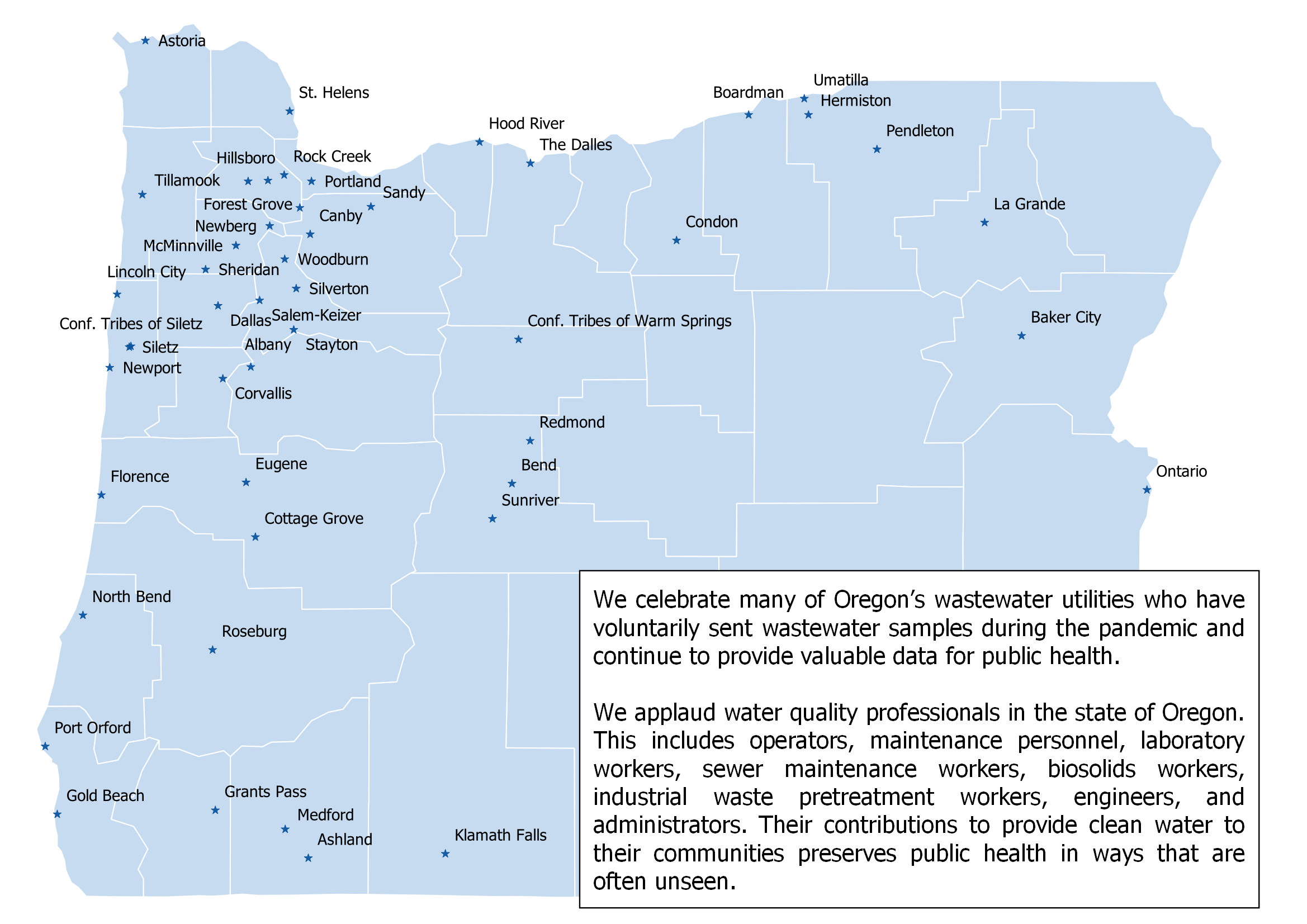Wastewater Sample Analysis Pause over the Holidays. We will pause the analysis of wastewater samples over the holidays. Results will be reported the weeks of December 22nd and January 5th, but not the week of December 29th. All samples sent during the holidays will be analyzed and reported during the week of January 5th.
CDC NWSS Measles Dashboard Link added to OSU Wastewater Surveillance Website. Results are reported as a detection or non-detection of the wild-type virus for each utility.
“Enhancing Public Health Through Wastewater Surveillance” Faculty Lecture. Dr. Tyler Radniecki, professor of Environmental Engineering at OSU and one of the principal investigators of the Oregon Wastewater Surveillance program, will be presenting January 6th from noon to 1 pm via Zoom. Free and open to the public. Register here: https://events.oregonstate.edu/event/COE-faculty-lecture-with-Radniecki
“This presentation covers how wastewater surveillance in Oregon went from an academic research project to a state-wide implementation in a matter of months. … Additionally, this presentation describes how our intentional and consistent collaboration between varied stakeholders helped Oregon create one of the strongest wastewater surveillance networks in the country. Finally, this presentation points out where wastewater surveillance is heading in the future.”
Washington County Public Health Use of Wastewater Surveillance Data Testimonial from Catherine Desmarais, DrPH, Communicable Disease Epidemiologist:
“As an epidemiologist, I utilize the wastewater data weekly when giving my review of respiratory disease trends in our county to our team. As many are aware, COVID testing behavior has changed significantly over the last five-and-a-half years. Most people now test for COVID in their homes, and those results are not reported to the state and thus are not counted in the weekly percent positivity calculations. Many people are not even testing at home if they have respiratory symptoms anymore. So overall, the percent positivity of COVID tests is a significant underestimate of circulating virus and old and new numbers are not comparable. This is where wastewater monitoring comes in and why it is so important to our team. It does not rely on testing behaviors or care seeking by cases and is consistent throughout the course of the pandemic. Wastewater gives us an estimate of the true burden of the disease regardless of outside factors. The wastewater data, when timely, provides context to the percent positivity numbers and is valuable to our planning processes seeing wastewater concentrations often rise before we see the associated increase in test percent positivity. For example, knowing that viral concentration is rising in local watersheds allows the team to shift workloads so they are better able to respond to respiratory outbreaks and provide resources to facilities in need of assistance in controlling their outbreaks. The inclusion of variant data also allows us to plan for case spikes when we see a novel variant reach ~50% of circulating variants. In summary, wastewater is by far the most consistent and accurate tool to estimate disease burden in the community and we use it regularly for monitoring, planning, and prevention purposes. As an aside, wastewater and variant data is also used in hospital and health system calls during the respiratory season for similar purposes.”
QR Code Required on Postage Labels. Thank you to all utilities for working through the postage label issues and ensuring QR codes are present on all sample return envelopes. We are happy to report we have been receiving all samples! (Also, envelopes with postage stamps do not require the code.)

Active Utility Participants
Albany: Sanitary Sewer System | City of Albany Oregon
Ashland: Water Treatment Plant | City of Ashland Oregon
Astoria: Public Works Department | City of Astoria Oregon
Bend: Wastewater | City of Bend Oregon
Boardman: Public Works | City of Boardman Oregon
Canby: Wastewater Treatment Plant | City of Canby Oregon
Corvallis: Wastewater Treatment | City of Corvallis Oregon
Dallas: Public Works | City of Dallas Oregon
Durham: Durham Water Resource Recovery Facility | Clean Water Services
Eugene: Metropolitan Wastewater Management Commission | Eugene–Springfield Oregon
Florence: Wastewater Division | City of Florence Oregon
Forest Grove: Forest Grove Water Resource Recovery Facility | Clean Water Services
Grants Pass: Public Works Department | City of Grants Pass Oregon
Hermiston: Public Works | City of Hermiston Oregon
Hillsboro: Hillsboro Water Resource Recovery Facility | Clean Water Services
Hood River: Sanitary Sewer System | City of Hood River Oregon
Klamath Falls: Public Works | City of Klamath Falls Oregon
Lincoln City: Public Works | City of Lincoln City Oregon
McMinnville: Water Reclamation Facility | City of McMinnville Oregon
Medford: Water Reclamation Division | City of Medford Oregon
Newport: Public Works | City of Newport Oregon
North Bend: Wastewater Department | City of North Bend Oregon
Ontario: Wastewater Treatment | City of Ontario Oregon
Pendleton: Public Works | City of Pendleton Oregon
Portland: Environmental Services | City of Portland Oregon
Rock Creek: Rock Creek Water Resource Recovery Facility | Clean Water Services
Roseburg: Wastewater Treatment | Roseburg Urban Sanitary Authority
Salem: Wastewater | City of Salem Oregon
Silverton: Wastewater Treatment Plant | City of Silverton Oregon
St. Helens: Waste Water Treatment | City of St Helens Oregon
Stayton: Public Works | City of Stayton Oregon
Sunriver: Sunriver Utilities | Sunriver Oregon
The Dalles: Wastewater and Stormwater | City of The Dalles Oregon
Tillamook: Wastewater Treatment Operations | City of Tillamook Oregon
Wilsonville: Wastewater Treatment Plant | City of Wilsonville Oregon
Woodburn: Wastewater | City of Woodburn Oregon
OHA/OSU Joint Press Release for Utility Appreciation Outreach - 7/17/23
Wastewater treatment plants recognized for role in tracking COVID-19 transmission - KEZI 9 News 7/17/23
OHA thanks wastewater utilities for their help in monitoring COVID-19 - KOBI 5 News - 7/17/23